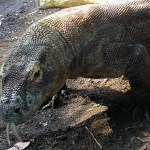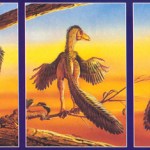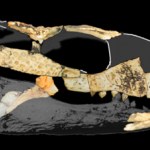herpetology
I promised myself back in 2007 that I'd cut down on the number of conferences I attend. There's a problem with that: I'm pretty bad at keeping promises (at least, to myself). This year I'm attending a ridiculous four conferences, and I've just returned from the first of them (please remind me why I have no money, and no spare time). Entitled Sea Dragons of Avalon: the early radiations of the marine reptiles and recovery from the Triassic-Jurassic faunal crisis, with special reference to Street in Somerset and the wider British record, this Palaeontological Association (Pal Ass) seminar…
If you've been paying attention you'll know that I've been absent for a little while: I've been at the Sea Dragons of Avalon conference, held at Street in Somerset and focusing on the evolution of marine reptiles (and other organisms) across the Triassic-Jurassic boundary. The meeting also included a tribute to Arthur Cruickshank, a day of 'Arthur-themed' talks, and a public lecture by Ryosuke Motani. And then there were collection visits and field trips; all in all, a major event. It went well and I have a lot to talk about: more details soon (for information on the sign shown in the…
The third episode of Inside Nature's Giants (still available to watch, if you're in the UK) looked at a 17-year-old, 4 m long Nile crocodile Crocodylus niloticus that had died (very much prematurely) at a crocodile park in France (please read part I and part II unless you have already). RVC pathologist Alun Williams tried to work out the cause of death. Greg Erickson was the on-site crocodile expert, so (as expected) jaw anatomy and bite force were focused on to begin with (see Erickson et al. 2003a, b). The pterygoideus muscles - you can see some of them here, with Erickson in the…
Yesterday I did a day of work in London. Because everything finished far earlier than I was anticipating, I had time to kill so, accompanied by trusty sidekick John Conway, what else could I do but spend a few hours at ZSL's London Zoo (ZSL = Zoological Society of London)? We had a great time and saw some neat creatures: here are a few of the highlights. We start with one of the most awesome creatures on the planet...
Yes, the incredible Komodo dragon Varanus komodoensis. To be honest I'd forgotten that they have them there: I think there are also dragons at Chester Zoo, Colchester Zoo and (…
That cute little Mexican snake was, obviously, a 'colubrid'. That means, essentially, that it's a colubroid snake that isn't a viperid, elapid, or a member of any of the other obviously distinct colubroid clades (more on this matter below). Its small size, short-snouted, wide head and proportionally enormous eyes at least suggest that it's a juvenile. The fact that it was photographed in Mexico, and in a region of scrubland and desert, helps narrow down the possible identities. I initially thought it was a lyre snake (Trimorphodon): they tend to have a light grey ground colour, dark grey/…
The naming of new amphibian species is a fairly routine thing. This doesn't mean that - despite the global amphibian crisis - amphibians are actually ok and that we can stop worrying; it means that we haven't been paying enough attention, and indeed many of the species that are being named anew are endangered, or threatened, or with tiny ranges.
The current edition of Journal of Zoology includes the description of a new plethodontid salamander (aka lungless salamander): the Patch-nosed salamander Urspelerpes brucei Camp et al., 2009. The big deal about this entirely new species is that it's…
The recent discovery that some Asian microhylid frogs frequent the dung piles of elephants has gotten these obscure little anurans into the news, possibly for the first time ever. Microhylids - or narrow-mouthed frogs - are not exactly the superstars of the frog world: they're only really familiar to specialists, despite the fact that (as of June 2009) they contain over 450 species distributed across Africa, Madagascar, the Americas, and Asia. However, some more recent research on the group shows that, like so many animals, they're really quite interesting once you get to know them...
You…
My mate Bob Nicholls (of Paleocreations) has been producing some awesome artwork lately. Why, for example, there's this...
... and this...
The first illustration (both pics © Bob Nicholls and used with permission) shows the Jurassic pliosaur Liopleurodon Pliosaurus performing its usual trick: modifying other plesiosaurs such that they become manageable chunks. In the second piece, a group of the Cretaceous ichthyosaur Platypterygius prey on fish. As I'm sure I've said before, Platypterygius encompasses a pretty substantial diversity: numerous species have been named and it's likely that '…
For millenia, a battle has raged between alligators and water melons. Who will win? Well, the answer's obvious: one has a bite force of over 15,000 Newtons, and the other one's a water melon. Yes, the alligator vs water melon craze has gone mainstream, as testified by its appearance on Sky News... though, god help them, they managed to mistake an alligator for a crocodile. Hopeless. Anyway...
It's gratifying and amusing to see an alligator destroy a water melon with such devastating ease [for more information, see the accompanying text at youtube]. But there are a few other things of interest…
It's well known that elephants have a major impact on their environment: indeed, they're what's known as ecosystem engineers. In a new study, Ahimsa Campos-Arceiz of the University of Tokyo reports that Asian elephant dung might serve a hitherto unreported role as a microhabitat for certain small frog species. While inspecting Asian elephant Elephas maximus dung piles on Sri Lanka in 2008, Campos-Arceiz was surprised to discover individuals of the microhylid frogs Microhyla ornata and M. rubra and a species of the dicroglossid Sphaerotheca [shown here] hiding inside or under the piles (if…
At some stage, I'll have to write full-length articles on lysorophians, aïstopods, the remaining temnospondyls, nectrideans, microsaurs, and assorted other groups of Palaeozoic and Mesozoic non-amniote tetrapods. Alas, this hasn't happened yet. In the meantime, here are some slides from one of my talks...
Lysorophians are peculiar, long-bodied lepospondyls from the Carboniferous and Permian, best known for Brachydectes. They had strongly reduced limbs and limb girdles and elongate skulls, typically with a strongly emarginated cheek region. Trace fossils suggest that some species were…
In the previous article we looked at the Birds Come First, or BCF, hypothesis. It goes without saying that BCF has not won acceptance in the community, nor - in fact - is it even familiar to the majority of archosaur workers. Here, we take a critical view of BCF: does it stand up, or does it fail?
To begin with, let me note that the underlying premise of BCF is fundamentally problematical: the idea that there is some sort of 'central trunk' (Olshevsky 1994, p. 42) or single, unbroken lineage that extended from the first stem-archosaur to the most recently evolved, modern bird. Old 'family…
A substantial amount of evidence demonstrates that birds are theropod dinosaurs, and that birds evolved during the Jurassic from small, feathered maniraptoran theropods closely related to dromaeosaurids and troodontids (known collectively as deinonychosaurs) [the small dromaeosaurid Microraptor shown in adjacent image]. The precise details of avian origins remain the subject of debate, and argument continues over whether proto-birds were tree climbers, leapers, terrestrial cursors, or combined some of these lifestyles. But because basal deinonychosaurs were small animals (not much different…
Last year was Year of the Frog (nothing to do with the Chinese calendar, but instead a global effort to raise awareness about the plight of the world's declining amphibian species). I hope that you've not forgotten that the global effort to slow amphibian extinction continues unabated. For various reasons, I haven't blogged about amphibians for a while, so, in an effort to bring balance (something I strive for, yet will always fail to achieve) I feel the need to bring you up to speed. What has happened lately in the world of amphibian conservation? [Pirri harlequin frog shown here: a species…
Welcome to one of those annoying teaser posts - I'd post something substantive, if only I had the time.
But I don't.
The adjacent photo shows Pristimantis charlottevillensis, a strabomantid from Tobago that was named in 1995. Believe it or don't, strabomantids are sometimes known as squatting prophet frogs. The group was only named in 2008, and was previously included within the hyloid group Brachycephalidae [previously discussed here].
The photo was taken by John C. Murphy and is used with his kind permission.
Hey - how do people get those open thread things going?
The proofs for one of my books arrived the other day, so I have been busy busy busy. This (in part) explains the lack of action here on the blog, and the preponderance of recycled stuff. Sorry about that. In fact, sorry, here's another recycled article from Tet Zoo ver 1. Hopefully I'll have the time to produce some new content over the next week, but don't hold your breath. And sorry about all the dinosaur stuff: I know you much prefer it when I post on frogs, lizards, mice and passerines. Anyway...
As a kid I always got the impression from textbooks that the only tetrapods (and thus only…
No time to produce anything new, so here's another recycled book review...
While the Mesozoic strata of Patagonia are particularly well known for their diverse and often spectacular dinosaurs, they have also yielded a phenomenally rich record of other Mesozoic reptiles, including turtles, squamates, plesiosaurs, ichthyosaurs, crocodilians and pterosaurs. In this multi-authored volume (another contribution to Indiana University Press's Life of the Past series), Gasparini, Salgado and Coria have edited a collection of 14 papers on the region's Mesozoic reptiles, and on their geological context…
It might not be well known outside of palaeontology that the south-west of England is famous for its marine reptile fossils. But it is: some of the best, most historically significant, plesiosaur and ichthyosaur specimens have come from Street in Somerset and from Lyme Regis and Charmouth in Dorset.
These rocks - spanning the Triassic-Jurassic boundary and known collectively as the Lower Lias - yield the giant, robust-skulled ichthyosaur Temnodontosaurus, the swordfish-like Leptonectes and Eurhinosaurus, and the more familiar, dolphin-like Ichthyosaurus. The long-necked plesiosaurs…
In the previous post we looked at the small, island dwelling crocodilians of the south-west Pacific. I personally find it exciting that such animals were (in the case of at least some of the species) alive until just a few thousand years ago, that they were encountered by people, and that their remains have eluded detection until recent decades. The odds are high that further species await discovery. Here's another article that originally appeared at Tet Zoo ver 1.
Before we get to the new stuff, here's something relevant to the mekosuchine article: a never-before-seen skull reconstruction…



















